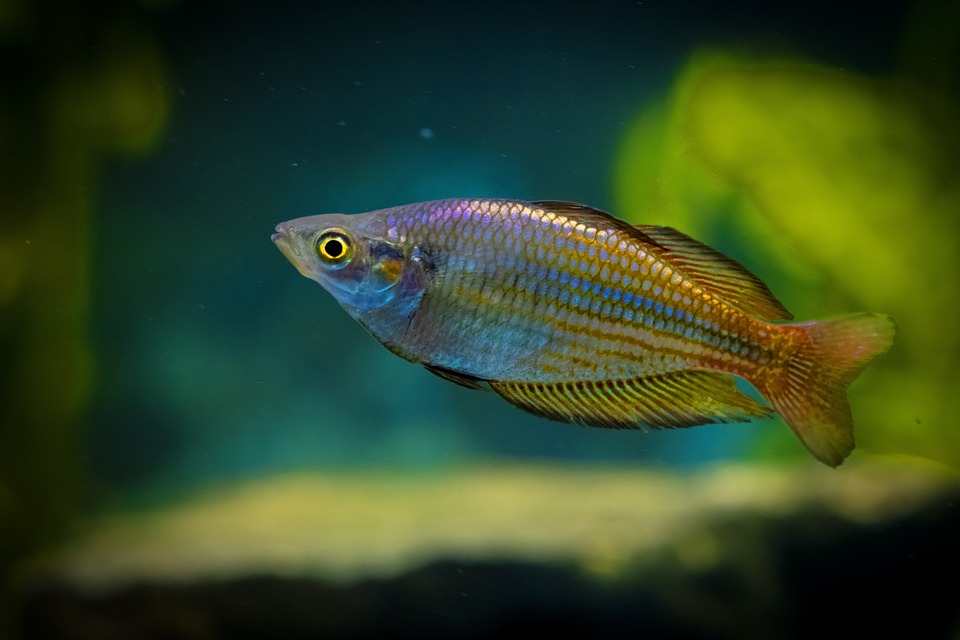The rainbowfish is a small, colorful, active fish residing in freshwater. Aquarists often keep them in large, communal tanks with widespread popularity. As amiable as it looks, are rainbow fish aggressive?
As a group, rainbowfish tend to be peaceful. They’re friendly with people and cheerful in groups of six or more. On the other hand, they will show oddly in some cases. Scroll down for more lesser-known facts about the fish as well!
Contents
Are Rainbow Fish Aggressive?

Yes. It’s up to the specific situation.
Many aquarium keepers have rainbowfish as pets. Since they are relatively placid, they are usually kept in groups of six or more. Their positive attitude and cute demeanor make them a pleasure to be around.
Still, they may become hostile from time to time. During the mating season, the males of these fishes may become very fierce, which can lead to fatal conflicts between individuals.
Other aquarium inhabitants, poor water quality, feeding-time struggles, or an overcrowded tank may all contribute to their violent behaviors.
Top Reasons Why Are Rainbowfish Aggressive?
Fishkeeping Mistake
Many aquarium keepers believe that by housing much male fish in a single tank, they would be able to train their fish to be more well-behaved and friendly.
This, however, may be a mistake since the dominant fish in a narrow tank will frequently pick on the docile and frail fish, raising the tension and risk of violence.
Lack Of Tank Space
Rainbowfish are a type of fish that swim in schools. They need a lot of swimming space and can become stressed if they don’t have it.
In case the tanks are too narrow to accommodate all of their fellows, they can become stressed and aggressive toward other tankmates.
They will begin flashing at one another, biting, harassing, chasing, and even fin-nipping.

Aggressiveness During Mating
Predators like the rainbowfish might use their flashy appearance to entice potential partners.
During the spawning season, most fish are cooperative. In contrast, during the mating season, some males may display violent behavior as the dominant male strives to establish his territory.
To mate successfully with a female rainbowfish, the dominant male will pursue and fight any other males who get in his way.
Lack Of Eating Opportunities
Rainbows are usually considered a docile fish species among the most common aquarium residents.
There are reports from some rainbow fish keepers that their pets get aggressive at feeding time and won’t let the other fish eat.
One possible explanation is that they see the other fish in the tank as parasites or competitors.
Because of this, there is not enough food for the others. Without enough food, the fish might get frail and eventually die.
How To Mitigate Rainbowfish Aggressiveness?

Determine The Sign Of Aggression
The most obvious signal of a fight is when one of your fish begins chasing another around the tank, but most aggressive behaviors are more covert.
Fighting between fish often happens out of sight, and you only find proof after the event.
You may also spot other signs of illness or injuries. Some telltale signs of a battle are fin damage; suspicious behavior; territorial shifting; scratches, cuts, blood tears, and hernias.
Decoration Can Control Aggressiveness
When designing an aquarium, it’s crucial to know what to include to provide a suitable living space for huge and hazardous animals.
Adding seaweed, snails, and other structures to obscure sightlines is excellent.
Using smoothed-water river boulders is optimal to make for great rockwork and is even used interchangeably with driftwood. Use these pieces creatively to create an artful and natural-looking aquarium that fits along with its setting.
Other viable solutions include offering more space or hiding spots for the fish and adding more toys or plants to the tank.
Be alert to the sharp corners and rough surfaces within the aquarium, as they can seriously threaten a fish’s life while it tries to escape the chasers. Rule out these 4 objects, as well.

Sufficient Tank Space
The school population expansion can reduce cases of harassment and strain significantly. Providing more room for the other fish to establish their territories may also be beneficial.
For six or more rainbows, you’ll need a tank at least 15 gallons long. The minimum tank size for rainbow fish larger than 3 inches is 30 gallons.
Tank capacity should be increased by 2 gallons for every additional tiny rainbow and by 5 gallons for every new big one.
Feeding Strategy
If your fish often get angry during feeding time, you’d better feed them on the other side of the tank.
As such, they will be unable to act aggressively against others. After you’ve relocated the rainbow fish to one side of the aquarium, you may safely feed the fish on each side.
Perfect Group Size
It’s possible to keep several different kinds of rainbow fish together, and fish of comparable size should stay in groups of at least six, as stated.
This is because they will get along best with others of a similar disposition and character if forced to share food and space.
To minimize injury, they need to be housed in a communal tank with other fish species that are just as friendly. Having three females for every two males eases conflicts and makes the fish less challenging to care for.
The Bottom Line
Are rainbow fish aggressive? Now that you’ve known the answer!
Whether you’ve always loved fish or are just looking for a way to incorporate one into your house, you can’t deny the aesthetic value of fish, notably rainbow ones.
Still, some ordinary owners probably don’t know much about their chosen species, causing inevitable damage. Hopefully, this post helps you prevent incidents better and care for these awe-inspiring fish the right way.

